Unfortunately, there has been a spate of recent films and TV series which glorify criminals and put cops, prison officials, and other law enforcement professionals as either background characters, or worse, corrupt and otherwise unsympathetic characters. By contrast, the criminals are the protagonists in these dramas, and viewers are supposed to feel sympathetic and empathetic towards them. And in many cases, they are supposed to feel hostile towards the corrupt or inept officials at all levels of the criminal justice system — especially cops and prison wardens and guards.

One example of this trend is Making a Murderer, now in its 2nd season, which makes it appear that the police, prosecutors, and courts in Manitowoc County, Wisconsin, all ganged up against Steven Avery. Allegedly, they planted evidence and extracted a false confession from a neighbor, Brandon Dassey, who implicated Avery in a rape torture murder. But Avery’s new lawyer in the series suggests there were two other killers and the local police and officials ganged up against Avery and Dassey, since Avery filed a $36 million suit against the county after he was falsely imprisoned for 18 years for a rape which someone else committed.
Another example of this trend to glorify criminals and disparage law enforcement is Orange Is the New Black, now in its 7th season, where the prison management and guards are shown variously as inept, money hungry, and brutal in unfairly treating prisoners, especially after the prisoners have rioted because of their poor treatment.
However, such films and TV series present a very biased portrait of crime and criminal justice, whereas in Crime in America, criminal justice expert Paul Brakke seeks to present a more balance view from a conservative perspective. For example, in one chapter dealing with the misleading portrait of the police who have been involved in shooting suspected criminals, Brakke discusses how the police are often demonized by the media.
As he points out, too much media attention is given to those protesting against police brutality and against the court verdicts that have mostly supported the police who have correctly employed the use of force guidelines, such as shooting when in fear for their lives. But the media and protesters tend to downplay the fact that the suspect had a knife or gun and appeared to be reaching for or about to shoot it, or was trying to drive a car at an officer who then shot the driver.
While Brakke doesn’t specifically write about these films or TV series in his book, his ideas can readily be applied to assessing the misleading perspective in these films that present cops, prison officials and other law enforcement professionals in a bad light.
Accordingly, viewers should understand that these films reflect a liberal perspective, and they should be ready to consider the incidents in the film or TV show from a more conservative perspective. For example, they might recognize that the portrait in a TV show like Making a Murderer is one-sided, so maybe there was no police-county conspiracy to manufacture evidence or compel a false confession, and there is no alternate explanation than Avery really did commit the murder.
Then, too, viewers might recognize that most prison officials and guards are dealing with a very difficult and dangerous population, and for the most part, they are trying to do the best they can with limited funds. In short, Brakke feels it is necessary to apply a more conservative perspective to considering how to cut down crime and deal with the problems in the criminal justice system in order to counter the usually liberal perspective of most commentators and writers on the subject.
This is one reason that Brakke has written Crime in America, the first in a series of books on crime and the criminal justice system written for the general public, after writing seven books on the subject directed towards a more professional and academic audience. These previous books include The Costly U.S. Prison System, The Price of Justice in America, and Fixing the U.S. Criminal Justice System.
Crime in America is designed to provide an overview of crime patterns and how the criminal justice system works — or doesn’t work . Then, Brakke offers suggestions for improving it and dealing with specific crises, such as the opioid epidemic and the threat of rampant immigration. These are connected, as he points out, since there really is an association of crime and immigration, because younger immigrants are more likely to turn to drugs and crime than non-immigrants of the same age.
Thus, while these films often glorify action and violence as a way to hook an audience, Brakke suggests more everyday community-based solutions to help individuals become more productive citizens, preserve family unity, and create stronger communities. This way, with closer, more cohesive communities, supportive friends, and jobs, individuals have less incentive to return to any type of crime, including even committing a mass murder.
As Brakke points out, this strategy works to help ex-cons avoid returning to prison, and it could similarly help to keep prospective mass murderers from killing anyone. This approach may not be as exciting as a movie or TV show featuring violence and double dealing by the main and supporting characters, but it’s what has been shown to work in many countries and in communities within the U.S.
To learn more, you can now get a free review copy of Crime in America, which is available for preorder, too. Brakke is offering these books for free to anyone who wants to review and comment on the book. Also, copies are now available for government officials who might turn some of these suggestions for reducing crime and fixing the criminal justice system into legislation. Members of the media are also invited to request copies of the book.
To help draw attention to these suggested fixes in the book, Brakke has additionally launched a video and social media campaign with five new videos each day. The first 10 are featured on his American Leadership Books’ YouTube channel. Among the most recent videos are:
“Want to Know More about U.S. Crime?”
and, “The Immigration Debate”
Brakke brings to this discussion of crime and the divisions in American society an extensive background in researching the subject as the publisher of American Leadership Books and the author of seven books. Six of them deal with what to do about crime in America and one deals with understanding and healing the great national divides in America.
Other past books besides those already mentioned include: Dealing with Illegal Immigration and the Opioid Crisis and Cops Aren’t Such Bad Guys. Since these first books were designed especially for law enforcement professionals, government officials, and academics, Brakke is now adapting these books for a general audience and will be bringing out his next books — Fractured America and Prisons in America — in the next few months.
Copies of Crime in America for review are available to the general public at no charge at crimeinamericathebook.com. For media copies of the book, along with additional information on American Leadership Books and Paul Brakke and to set up interviews, please contact:
Jana Collins
Jones & O’Malley
Toluca Lake, California
jana@jonesomalley.com
(818) 762-8353




